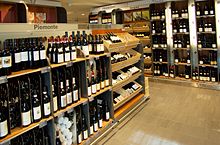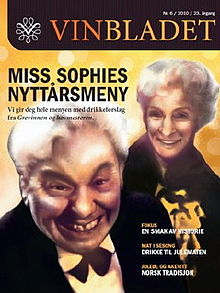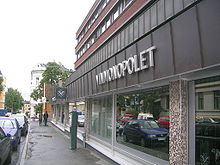- Vinmonopolet
-
Vinmonopolet 
Type Government enterprise Industry Wine, Liquor Founded November 30, 1922 Headquarters Norway Number of locations 266 Key people Kai G. Henriksen (CEO) Products Alcoholic beverages Employees ca. 1800 Website vinmonopolet.no Vinmonopolet (English: The Wine Monopoly), symbolized by Ⓥ and colloquially shortened to Polet, is a government owned alcoholic beverage retailer and the only company allowed to sell beverages containing an alcohol content higher than 4.75% in Norway.
As the arm of the Norwegian government policy to limit the citizens' consumption of alcohol, primarily by means of high cost and limited access, the primary goal of the Vinmonopolet is to responsibly perform the distribution alcoholic goods while disassociating the motive of private profit from the alcohol industry. Equally significant is the social responsibility of Vinmonopolet, to prevent the sale of alcohol to minors and visibly inebriated customers.
Outlets, located across the country from cities to smaller communities, typically close business earlier than other shops, normally weekdays at 18:00 and Saturdays at 15:00. In 2007 Vinmonopolet sold 71,100,000 litres (18,800,000 US gal) of alcohol.[1]
Contents
Foundation
The institution was founded in 1922 as a government-owned company as the result of trade negotiations with wine exporters, mainly France. The ban on alcohol was lifted, and sale was allowed through outlets run by Vinmonopolet.[2]
Since 1939 the state, initially through the Norwegian Ministry of Finance and later the Norwegian Ministry of Health and Care Services, has been the sole owner, buying out the private shareholders while remaining a stock company.[3]
The company's import and production activities ceased in 1996 when the EFTA ruled that the monopoly was in violation of the EEA agreement, the company divided into the created company entity Arcus which continued all production, import and distribution activity of spirits, leaving Vinmonopolet as a sole retail monopoly.[1]
In 1999 the format of the outlets was restructured, making nearly all stores self service from the previous format of sales over the counter, and internet sales began in 2002.
Consumer relations
 Inside the Vinmonpolet Briskeby outlet
Inside the Vinmonpolet Briskeby outlet
In a 2008 survey by Norsk Kundebarometer, customers of the monopoly were 81.5% satisfied with the company, ranking it 4th in Norway,[4][5] a figure that rose to 88% in 2009.[6] There are critical voices, however, that have questioned the institution's selection process of allowing a small self-recruited group, termed "the taste bureaucracy", make the wine buying decisions on behalf of the entire Norwegian people.[7]
The institution has not stayed clear of problems. In one instance in 2001, the published price list offered Château Latour at the incredibly priced NOK 555, where an estimate would normally be approximately NOK 2,600, causing the quickest three customers to order to buy up the entire inventory, with the intent to make a fast and considerable profit. The explanation was that the more modestly priced Château Latour à Pomerol had its name listing edited down for brevity.[8]
Surveys from the mid 90s, indicated a majority of the Norwegian population were in support of dissolving the monopoly arrangement, and allowing for the sale of wine by the private sector.[1] Since the restructuring of 1996, the consumer satisfaction steadily increased, the events described by current CEO Kai G. Henriksen as "the lifting of the import ban was a stroke of fortune. Today we have 210 importers competing to find the most reasonably priced, the best and most glorious wines of the world."[1]
Robert Lie, then sommelier of Bagatelle, has stated, "I am among the supporters. In recent years Vinmonopolet has had great impact on the wine interest of the average Norwegian. To my knowledge there are no wine stores in the world with an equal selection. There are also fairly good prices for more expensive wines. For highly coveted wines one must pay much more in London."[1] Torkjell Berulfsen, presenter of considerable TV programming with focus on alcoholic goods, has stated, "These days I praise Vimonopolet into the clouds. I bless it! I don't dare imagine some zitty, unmotivated 25-year old 'red wine supervisor' at Rimi!"[1]
Arne Ronold MW has pointed to the formats of UK and Denmark as successful alternatives that offer good selections in supermarkets and specialty stores, while stating that the present situation offers a wide selection for consumers in certain areas but with considerably more limited options for some other areas, and while more costly wines may be less expensive in the Vinmonopolet format, this is a "positive side-effect of a market that doesn't work, being of little benefit to the average consumer". He acknowledges "a near-revolution in that at present there are more than 10,000 products available, which is wonderful", adding, "I have been among the most ardent critics but have mildened somewhat. I am adequately satisfied with Vinmonopolet as it is now. But they still have some way to go concerning aged wine and the second hand market. In this, access is poor."[1] Ronold's publication Vinforum which 1986 founding was motivated by the perceived poor performance of Vinmonopolet,[9] whose Italian wine selection then totalled 14 labels including reds, whites and sparkling. By 2010 the category had risen past 2,000 labels, leading co-founder Ola Dybvik to declare, "we are living in paradise", continuing in context that the Norwegian population is comparative to a New York suburb, "in terms of selection, the store has moved into the definitive world elite".[6]
In a commentary by Tom Marthinsen, then wine critic of Dagens Næringsliv, also acknowledged the progress from the conditions of the 1990s, but was critical to the direction of applying new techniques from chain stores which lead to standardization of the urban outlets, while contending that the rural stores have a "catastrophical selection", and these consumers from "the districts" would benefit from purchasing wine in their local food store. Marthinsen called upon the leadership to "set free the store buyers, reinstate the competitive element between the stores, in other words leave behind the chain store mentality and allow local creativity to flourish".[10]
In December 2008, Vinmonopolet announced plans to implement a system of arranging auctions of second hand wine, similar to the model in use by Swedish Systembolaget.[11] Under current Norwegian law it is illegal to sell alcohol by auction.[12]
It became the stated ambition of Vinmonopolet to be "the world's premier wine store", in 2010 presenting figures and goals for the future concerning diversity of available products and customer service quality philosophy. Vinmonopolet offered more than 12,000 products, next to 2009 figures from comparative retailers such as Systembolaget which offered ca. 9,000 products, Alko of Finland with ca. 3,000 products available, or British Waitrose with ca. 1,500 products available.[6]
Special shops
Two Vinmonopolet outlets have status as "special shops", with one each located in Oslo (Vika, formerly Briskeby) and Bergen (Valkendorfsgaten). It is a stated goal to develop more "special shops" over time in other larger Norwegian cities.[13] These outlets launch new products on the first Thursday of every month (except July), to supplement a special selection of approximately 750 products not available in the ordinary product list, described to be of "either innovative, limited availability or of an exceptionally high quality". As with all wine purchased in the normal outlets, Vinmonopolet guarantees the provenance of these uncommon wines, and the customer retains the regular right to return faulty wine for the money back within five years of purchase.[14][15]
Though the available quantities of the special release wines can be very limited, some wines so sparse they entail minimal purchasing quotas in order to reach a wider public, prices may be as low as ⅓ or ¼ of world market value.[14][16][17] As a result of considerable enthusiasm surrounding these product launches, the trends of customer behaviour has come under criticism for sinking to an uncivilised level.[17][18][19]
Corruption cases
In what is known as Dysthesaken (the Dysthe case) in 1930 exposed flaws in the goods acquisition procedures of Vinmonopolet, and as a consequence changes were made to the procedures. The leadership were sentenced for combining company and personal interests, and the influence and power of individuals in purchasing decisions were reduced after the process.[3] Following this, a law of July 19, 1931 (Vinmonopolloven, the wine monoploy law) came into effect.[20]
Ekjordsaken, (the Ekjord case) uncovered in 2005, brought new allegations of corruption against employees and leadership of Vinmonopolet. A probe led by Erling Grimstad exposed that the importer firm Ekjord A/S over the course of several years had sponsored outlet leaders by arranging luxury dining and accommodations as well as other gifts in order to influence purchases and placement of their products within the stores. Membership in this exclusive group was symbolized by the gift of a tastevin.[21] Several Vinmonopolet leaders admitted to having received wines and other perks, which led to reprimands of 9 individuals, two of whom were dismissed.[22]
The initiating factor came when Svein Lindin, an employee who had been fired from Ekjord A/S, sued against wrongful dismissal. The scandal escalated as the media discovered the particulars of the lawsuit, with Lindin as the chief source of allegations that would result in wide consequences.[23] During the trial the elaborate "grease culture" in the company Ekjord A/S was uncovered.[21][24] Knut Grøholt withdrew from the position of CEO of Vinmonopolet later that year,[22] and in August 2006 was replaced by Kai G. Henriksen.[25][26][27]
Vinbladet
 Vinbladet November/December 2010, its cover depicting manservant James and Miss Sophie
Vinbladet November/December 2010, its cover depicting manservant James and Miss Sophie
Having long planned to publish a magazine aimed at consumers as was already done by Systembolaget in Sweden, in 1988 Vinmonopolet launched Vinbladet ("The Wine Magazine" or "The Vine Leaf"), distributed to customers free of charge.[28] The magazine's name had been used precisely 60 years previously for the internal publication which provided information to employees about the sold goods.[2] The rationale was that as Vinmonopolet were in the business of selling culture, they wanted to do so with culture, making information available crucial.[28]
A professional editor was engaged, and the publication printed on glossy paper contained images of a commercial nature depicting the diverse nations' wine regions and wine production, and articles on various subjects connected to food, wine and spirits. The Norwegian temperance movement reacted negatively and responded with press declarations accusing Vinmonopolet of attempting to popularise alcohol use, rather than limit it. The criticism from the temperance movement also maintained that the alcohol in wine did not distinguish itself from the alcohol in hard spirits, that "fine dining" customs functioned as a gateway to alcohol problems, and that the cultural projects of Vinmonopolet could well lead to family tragedies, destroyed lives, fear and death.[28]
Rødvin
When the German occupation forces withdrew from Norway in 1945, there remained behind 400,000 litres of Bordeaux wine which became the foundation of the generic "Rødvin" ("Red wine"), the best selling wine in Norway over several decades, which is accredited as a cornerstone in "cultivating Norwegian drinking culture".[29] Nicknamed "Château Hasle" (from the location name of the Vinmonopolet head quarters) and "Sekskroners" ("costing six kroner"), sales of the brand are estimated in excess of 120 million litres, it eventually ceased being the national top seller due to the arrival of inexpensive Chilean and Italian wines by 1998.[29]
The initial blends consisting of Bordeaux wines from the 1934 and 1937 vintages, along with simple German and Italian wine, were sold from January 1, 1946 for NOK total of 4.50, both Rødvin and Hvitvin (White wine), all sold out by 1947.[30] As the successive imports of wine from Algeria, Tunisia and Chile marketed under other names failed to sell well, an initiative was made in 1949 to compose a new blended wine for the people, affordable and easily drinkable. Purchasing director Haakon Svensson was given a set budget and assigned to negotiate deals with wine producers, initially securing deals with winemakers from Le Midi, Valencia and Algeria, with an aim to produce a blended wine that could decrease the Norwegian people's vast consumption of liquor, at the time ten to one the ratio of the consumption of wine.[29]
On sale from February 1, 1950 at the total price of NOK 6 (NOK 4 + 50% tax), the price remained fixed until 1968, causing it to be widely known as "the six kroner wine". By 1970 it cost NOK 7, and by 1990 it had risen to NOK 43.[30] Normally blended from 5 to 10 wines, from locations that later also included Cyprus and Turkey, Rødvin was in 1972 responsible for 40% of all wine sold in Norway, leading up to the peak of its popularity in the 1980s. In 1981 there was sold 3.8 million liter, while by 2000 Rødvin production had been transferred to Arcus and annual sales had decreased to 700,000 liters.[29]
Golden Power
Golden Power was a Norwegian-produced sparkling fruit wine (not to be confused with an energy drink of the same name), made of 70% rhubarb, 20% apple and 10% grape juice,[31] which was produced by Vingården (the Røed farm in Filtvet, in the Tofte area, in Hurum), associated with owner Frantz Michaelsen.[32] The product was removed from Vinmonopolet selection in 2006.
Vingården was considered part of the local culture,[33] and Golden Power deemed by some a rare, innovative Norwegian product.[34] Traditions of winemaking were established in 1886,[34] and Vingården came to have a production capacity of some 800,000 litres while the production process of Golden Power was claimed to last for four years. Near the end of its production, the company produced between 20,000 and 25,000 bottles annually.[34]
Other alcoholic monopolies
- Alko — Finland
- Systembolaget — Sweden
- Vínbúð — Iceland
- Provincial Liquor Crown Companies — Canada
- Liquor Control Board of Ontario — Ontario
- Nova Scotia Liquor Corporation
- Société des alcools du Québec — Quebec
- National Alcohol Beverage Control Association — United States
- Rúsdrekkasøla Landsins - Faroe Islands
References
- ^ a b c d e f g Anker, Nils, Dagens Næringsliv: D2 (November 14, 2008). "– Vi skal gjøre oss fortjent til folks støtte" (in Norwegian). http://www.dn.no/d2/d2mat/article1538626.ece.
- ^ a b Hamran, Olav; Myrvang, Christine (1998) (in Norwegian). Fiin Gammel – Vinmonopolet 75 år. Tano Aschehoug. pp. 39–71. ISBN 8251837383.
- ^ a b Hamran, Olav; Myrvang, Christine (1998) (in Norwegian). Fiin Gammel – Vinmonopolet 75 år. Tano Aschehoug. pp. 73–95. ISBN 8251837383.
- ^ kundebarometer.com Customer poll, search criteria - satisfaction (Norwegian)
- ^ Moe, Ingrid Elisabeth, Dagens Næringsliv (July 5, 2008). "Disse hater og elsker vi" (in Norwegian). http://www.dn.no/privatokonomi/article1397936.ece.
- ^ a b c Dybvik, Ola (January 2010). "Verdens beste vinbutikk" (in Norwegian). Vinforum 24 (1): 18–21.
- ^ Marthinsen, Tom, Dagens Næringsliv (September 6, 2008). "Polets forskjellsbehandling" (in Norwegian). http://www.dn.no/vinguiden/article1484661.ece.
- ^ Marthinsen, Tom, Dagens Næringsliv (November 14, 2001). "Latour-forviklinger for Vinmonopolet" (in Norwegian). http://www.dn.no/arkiv/article21256.ece.
- ^ Dybvik, Ola (January 2010). "Heia Norge!" (in Norwegian). Vinforum 24 (1): 7.
- ^ Marthinsen, Tom, Dagens Næringsliv (November 14, 2008). "Vinmonopolferd på feil kurs" (in Norwegian). http://www.dn.no/vinguiden/article1539682.ece.
- ^ Dn.no (December 31, 2008). "Vinmonopolet vil ha auksjoner" (in Norwegian). http://www.dn.no/vinguiden/article1574138.ece.
- ^ Dagbladet.no (December 31, 2008). "Vinmonopolet vil ha samlerauksjoner" (in Norwegian). http://www.dagbladet.no/2008/12/31/nyheter/vin/alkohol/4205246/.
- ^ Bø, Merete, Dagens Næringsliv (October 5, 2009). Satser på kresne kunder (Norwegian)
- ^ a b Jacobsen, Aase, Apéritif.no, (November 3, 2010). Bonanza for vellagret bordeaux (Norwegian)
- ^ Økland, Nils Are, Vinforum (March 30, 2009). Vinmonopolets dobbeltkommunikasjon (Norwegian)
- ^ Salvesen, Geir, Aftenposten (November 2, 2010). Se vinen som får 100 poeng av 100 mulige (Norwegian)
- ^ a b Skomakerstuen, Bjørn, Aftenposten (November 11, 2010). Solgte vin for 6 mill. på tre dager (Norwegian)
- ^ Økland, Nils Are, Vinforum (November 8, 2010). Min første polkø (Norwegian)
- ^ Økland, Nils Are, Vinforum (June 15, 2009). Rettferdig fordeling (Norwegian)
- ^ Lovdata.no. "Vinmonopolloven, LOV 1931-06-19 nr 18: Lov om Aktieselskapet Vinmonopolet" (in Norwegian). http://www.lovdata.no/all/hl-19310619-018.html.
- ^ a b Marthinsen, Tom; Linderud, Esben, Dagens Næringsliv (January 20, 2005). "Vinimportør smurte polsjefer" (in Norwegian). http://www.dn.no/vinguiden/article420120.ece.
- ^ a b Fadnes, Ole-Morten; Meyer, Henrik D, Dagens Næringsliv (December 2, 2005). "Polsjefen trekker seg - beholder lønnen" (in Norwegian). http://www.dn.no/vinguiden/article663086.ece.
- ^ Bakken, Laila; Steffensen, Christian, NRK.no (November 21, 2005). "Polblåser" i retten (Norwegian)
- ^ Marthinsen, Tom, Dagens Næringsliv (November 23, 2005). "Ekjord er verst" (in Norwegian). http://www.dn.no/vinguiden/article647816.ece.
- ^ Dalheim, Ulf, Adresseavisen (April 21, 2006). Polets nye direktør (Norwegian)
- ^ VG.no (April 21, 2008). Kai G. Henriksen ny sjef i Vinmonopolet (Norwegian)
- ^ Dn.no (April 21, 2006). Ny direktør i Vinmonopolet(Norwegian)
- ^ a b c Hamran, Olav; Myrvang, Christine (1998) (in Norwegian). Fiin Gammel – Vinmonopolet 75 år. Tano Aschehoug. pp. 369–399. ISBN 8251837383.
- ^ a b c d Glendrange, Sølvi, Dagbladet: Magasinet (May 6, 2002). "Polets lille røde" (in Norwegian). http://www.dagbladet.no/magasinet/2002/05/06/329243.html.
- ^ a b Holt, Morten, Horecanytt (January 2, 2008). Folkevin i ny drakt (Norwegian)
- ^ Apéritif.no Golden Power (Norwegian)
- ^ Wiik, Bjørn Cato, Østlandets Blad (November 29, 2008). Gå til glasset med din glede (Norwegian)
- ^ Tønsberg, Signe Ihlen, riksantikvaren.no (February 28, 2007). Minnefinnerne på Filtvet (Norwegian)
- ^ a b c Aftenposten.no (January 4, 2004). Sjelden norsk vare (Norwegian)
External links
- Vinmonopolet official presentation (English)
Government enterprises of Norway Argentum • BaneService • Electronic Chart Centre • Entra Eiendom • Flytoget • Gassco • Kings Bay • Mesta • Norsk Rikskringkasting • Norsk Tipping • Norwegian State Railways • Petoro • Posten • Secora • SIVA • Statkraft • Statnett • Store Norske • Uninett • VinmonopoletSee also: Category:Government-owned companies in Norway • List of Norwegian government enterprisesCategories:- Alcohol monopolies
- Alcohol in Norway
- Food companies of Norway
- Government-owned companies in Norway
Wikimedia Foundation. 2010.

